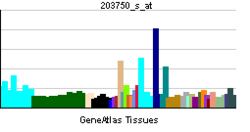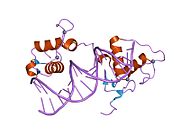Receptor retinoinske kiseline alfa
| Receptor retinoinske kiseline, alfa | |||||||||||
|---|---|---|---|---|---|---|---|---|---|---|---|
 PDB slika je bazirana na 1dkf. | |||||||||||
| Dostupne strukture | |||||||||||
| 1dkf, 1dsz, 1hra | |||||||||||
| Identifikatori | |||||||||||
| Simboli | RARA; NR1B1; RAR | ||||||||||
| Vanjski ID | OMIM: 180240 MGI: 97856 HomoloGene: 20262 GeneCards: RARA Gene | ||||||||||
| |||||||||||
| Pregled RNK izražavanja | |||||||||||
 | |||||||||||
 | |||||||||||
 | |||||||||||
| podaci | |||||||||||
| Ortolozi | |||||||||||
| Vrsta | Čovek | Miš | |||||||||
| Entrez | 5914 | 19401 | |||||||||
| Ensembl | ENSG00000131759 | ENSMUSG00000037992 | |||||||||
| UniProt | P10276 | Q3U3R3 | |||||||||
| RefSeq (mRNA) | NM_001033603 | NM_009024 | |||||||||
| RefSeq (protein) | NP_001028775 | NP_033050 | |||||||||
| Lokacija (UCSC) |
Chr 17: 35.72 - 35.77 Mb |
Chr 11: 98.75 - 98.79 Mb | |||||||||
| PubMed pretraga | [1] | [2] | |||||||||
Receptor retinoinske kiseline alfa (RAR-alfa), isto poznat kao NR1B1 (nuklearni receptor potfamilije 1, grupa B, član 1), je nuklearni receptor kodiran genom RARA.
Interakcije[уреди | уреди извор]
Pokazano je za receptor retinoinske kiseline gama da može da formnira interakciju sa NCOA6,[1][2][3] CLOCK,[4] TADA3L,[5] Cink prst i BTB domen-sadržavajući protein 16,[6] Src,[7][8] Nuklearni receptor srodni 1 protein (NURR1),[9] Mali heterodimer partner (SHP),[10][11] NPAS2,[4] Cyclin D3,[12] Nuklearni receptor korepresor 1,[13][14] BAG1,[15] Nuklearni receptor korepresor 2,[16][17] NRIP1,[18][19][20] Protein promielocitna leukemije[21] i Retinoidni X receptor alfa.[22][23]
Vidi još[уреди | уреди извор]
Reference[уреди | уреди извор]
- ^ Lee, S K; Jung S Y; et al. (2001). „Two distinct nuclear receptor-interaction domains and CREB-binding protein-dependent transactivation function of activating signal cointegrator-2”. Mol. Endocrinol. United States. 15 (2): 241—54. ISSN 0888-8809. PMID 11158331.
- ^ Lee, S K; Anzick S L; et al. (1999). „A nuclear factor, ASC-2, as a cancer-amplified transcriptional coactivator essential for ligand-dependent transactivation by nuclear receptors in vivo”. J. Biol. Chem. UNITED STATES. 274 (48): 34283—93. ISSN 0021-9258. PMID 10567404.
- ^ Ko, L; Cardona G R; Chin W W (2000). „Thyroid hormone receptor-binding protein, an LXXLL motif-containing protein, functions as a general coactivator”. Proc. Natl. Acad. Sci. U.S.A. UNITED STATES. 97 (11): 6212—7. ISSN 0027-8424. PMID 10823961.
- ^ а б McNamara, P; Seo S B; et al. (2001). „Regulation of CLOCK and MOP4 by nuclear hormone receptors in the vasculature: a humoral mechanism to reset a peripheral clock”. Cell. United States. 105 (7): 877—89. ISSN 0092-8674. PMID 11439184.
- ^ Zeng, Musheng; Kumar Ajay; et al. (2002). „Human papilloma virus 16 E6 oncoprotein inhibits retinoic X receptor-mediated transactivation by targeting human ADA3 coactivator”. J. Biol. Chem. United States. 277 (47): 45611—8. ISSN 0021-9258. PMID 12235159. doi:10.1074/jbc.M208447200.
- ^ Martin; Delmotte; et al. (2003). „PLZF is a negative regulator of retinoic acid receptor transcriptional activity”. Nucl. Recept. 1 (1): 6. PMID 14521715. doi:10.1186/1478-1336-1-6.
- ^ Kim, H J; Yi J Y; et al. (1999). „Activating signal cointegrator 1, a novel transcription coactivator of nuclear receptors, and its cytosolic localization under conditions of serum deprivation”. Mol. Cell. Biol. UNITED STATES. 19 (9): 6323—32. ISSN 0270-7306. PMID 10454579.
- ^ He, Bin; Wilson Elizabeth M (2003). „Electrostatic modulation in steroid receptor recruitment of LXXLL and FXXLF motifs”. Mol. Cell. Biol. United States. 23 (6): 2135—50. ISSN 0270-7306. PMID 12612084.
- ^ Perlmann, T; Jansson L (1995). „A novel pathway for vitamin A signaling mediated by RXR heterodimerization with NGFI-B and NURR1”. Genes Dev. UNITED STATES. 9 (7): 769—82. ISSN 0890-9369. PMID 7705655.
- ^ Seol, W; Choi H S; Moore D D (1996). „An orphan nuclear hormone receptor that lacks a DNA binding domain and heterodimerizes with other receptors”. Science. UNITED STATES. 272 (5266): 1336—9. ISSN 0036-8075. PMID 8650544.
- ^ Seol, W; Hanstein B; et al. (1998). „Inhibition of estrogen receptor action by the orphan receptor SHP (short heterodimer partner)”. Mol. Endocrinol. UNITED STATES. 12 (10): 1551—7. ISSN 0888-8809. PMID 9773978.
- ^ Despouy, Gilles; Bastie Jean-Nöel; et al. (2003). „Cyclin D3 is a cofactor of retinoic acid receptors, modulating their activity in the presence of cellular retinoic acid-binding protein II”. J. Biol. Chem. United States. 278 (8): 6355—62. ISSN 0021-9258. PMID 12482873. doi:10.1074/jbc.M210697200.
- ^ Dowell, P; Ishmael J E; et al. (1999). „Identification of nuclear receptor corepressor as a peroxisome proliferator-activated receptor alpha interacting protein”. J. Biol. Chem. UNITED STATES. 274 (22): 15901—7. ISSN 0021-9258. PMID 10336495.
- ^ Guidez, F; Ivins S; et al. (1998). „Reduced retinoic acid-sensitivities of nuclear receptor corepressor binding to PML- and PLZF-RARalpha underlie molecular pathogenesis and treatment of acute promyelocytic leukemia”. Blood. UNITED STATES. 91 (8): 2634—42. ISSN 0006-4971. PMID 9531570.
- ^ Liu, R; Takayama S; et al. (1998). „Interaction of BAG-1 with retinoic acid receptor and its inhibition of retinoic acid-induced apoptosis in cancer cells”. J. Biol. Chem. UNITED STATES. 273 (27): 16985—92. ISSN 0021-9258. PMID 9642262.
- ^ Dong, Shuo; Tweardy David J (2002). „Interactions of STAT5b-RARalpha, a novel acute promyelocytic leukemia fusion protein, with retinoic acid receptor and STAT3 signaling pathways”. Blood. United States. 99 (8): 2637—46. ISSN 0006-4971. PMID 11929748.
- ^ Hong, S H; David G; et al. (1997). „SMRT corepressor interacts with PLZF and with the PML-retinoic acid receptor alpha (RARalpha) and PLZF-RARalpha oncoproteins associated with acute promyelocytic leukemia”. Proc. Natl. Acad. Sci. U.S.A. UNITED STATES. 94 (17): 9028—33. ISSN 0027-8424. PMID 9256429.
- ^ Hu, Xinli; Chen Yixin; et al. (2004). „Suppressive effect of receptor-interacting protein 140 on coregulator binding to retinoic acid receptor complexes, histone-modifying enzyme activity, and gene activation”. J. Biol. Chem. United States. 279 (1): 319—25. ISSN 0021-9258. PMID 14581481. doi:10.1074/jbc.M307621200.
- ^ Farooqui, Mariya; Franco Peter J; et al. (2003). „Effects of retinoid ligands on RIP140: molecular interaction with retinoid receptors and biological activity”. Biochemistry. United States. 42 (4): 971—9. ISSN 0006-2960. PMID 12549917. doi:10.1021/bi020497k.
- ^ L'Horset, F; Dauvois S; et al. (1996). „RIP-140 interacts with multiple nuclear receptors by means of two distinct sites”. Mol. Cell. Biol. UNITED STATES. 16 (11): 6029—36. ISSN 0270-7306. PMID 8887632.
- ^ Zhong, S; Delva L; et al. (1999). „A RA-dependent, tumour-growth suppressive transcription complex is the target of the PML-RARalpha and T18 oncoproteins”. Nat. Genet. UNITED STATES. 23 (3): 287—95. ISSN 1061-4036. PMID 10610177. doi:10.1038/15463.
- ^ Benkoussa, Madjid; Brand Céline; et al. (2002). „Retinoic acid receptors inhibit AP1 activation by regulating extracellular signal-regulated kinase and CBP recruitment to an AP1-responsive promoter”. Mol. Cell. Biol. United States. 22 (13): 4522—34. ISSN 0270-7306. PMID 12052862.
- ^ Bugge, T H; Pohl J; et al. (1992). „RXR alpha, a promiscuous partner of retinoic acid and thyroid hormone receptors”. EMBO J. ENGLAND. 11 (4): 1409—18. ISSN 0261-4189. PMID 1314167.



